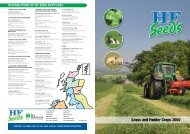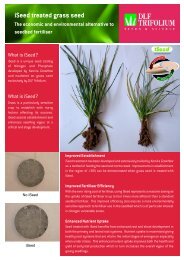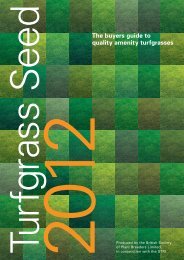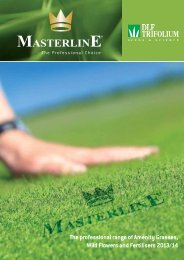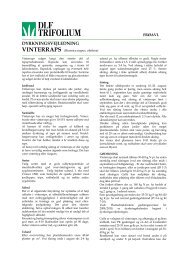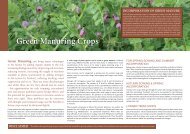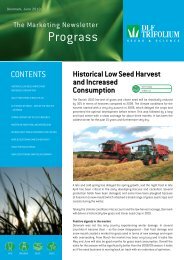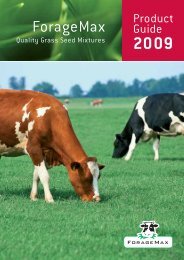HF Seeds England - dlf-trifolium
HF Seeds England - dlf-trifolium
HF Seeds England - dlf-trifolium
You also want an ePaper? Increase the reach of your titles
YUMPU automatically turns print PDFs into web optimized ePapers that Google loves.
Grass and Fodder Crops<br />
W H I T E C L O V E R<br />
White Clover is less productive then Red but it is much<br />
more persistent and is therefore used in medium to long<br />
term mixtures. Its leaves and flowers originate from<br />
creeping stems called stolons which grow very close to the<br />
ground giving them protection from even hard grazing.<br />
These stolons play a vitally important part in both clover<br />
production and persistence.<br />
The ideal grass and White Clover sward is one where the clover<br />
content is sufficiently large to optimise both its nutritional and nitrogen<br />
fixing abilities but which at the same time allows a high yield from the<br />
companion grasses. Typically clover should average at around 30%<br />
ground cover throughout the year but it may vary seasonally from as<br />
little as 5% in the spring to as much as 60% in mid and late summer.<br />
Vigorous stolon growth is essential for good clover production and persistence<br />
The following table shows the typical quality characteristics of White Clover compared to Perennial Ryegrass<br />
White Clover<br />
Perennial Ryegrass<br />
Digestibility (D-value) 75 – 85 65 – 75<br />
Crude Protein (%) 25 – 28 16 – 18<br />
Dry Matter intake by sheep (kg DM / day) 1.9 1.4<br />
Calcium content (%) 1.6 0.6<br />
Phosphorous content (%) 0.18 0.16<br />
Copper (parts per million) 10.0 6.5<br />
Selenium (parts per 100 million) 0.6 0.2<br />
The three most important factors in achieving the optimum clover content in a sward are as follows:<br />
Good Establishment<br />
Whether White Clover is being sown as part of a new reseed or<br />
overseeded into an existing pasture, the key to unlocking its full benefits<br />
begins with successful establishment. The optimum soil pH is 5.8 – 6.5<br />
and clover has a relatively high demand for phosphate and potash.<br />
Sowing rates should be around 1.0 – 1.5 kgs/acre (7% - 10% of the<br />
mixture by weight) and it should be sown shallowly into a firm, fine<br />
seedbed. Mixtures containing White Clover can be sown throughout<br />
the year but summer reseeds should be completed in time to allow<br />
stolons to develop before the onset of winter.<br />
Selection of the Correct Companion Grasses<br />
White Clover is essentially a poor competitor with grass and as the<br />
stolons are very dependent on light for their growth and development,<br />
tall open grasses are much more suitable as companion grasses than<br />
denser varieties. Thus the Tetraploid Perennials with their tall open<br />
growth habit and high yields are the ideal companion grasses to allow<br />
White Clover to thrive. In addition the high sugar content of Tetraploid<br />
grasses provides the ideal balance to the forage analysis of clover.<br />
Matching Clover Types and Varieties to Sward Use<br />
White Clovers are classified into three groups according to their leaf<br />
size, and to ensure long term clover survival, it is essential to match leaf<br />
size with the intended sward use.<br />
Small Leaved<br />
Small leaved White Clover varieties have a prostrate growth habit and<br />
are slow to establish but very persistent. They are ideal for close sheep<br />
grazing and will tolerate the poorer climatic and fertility conditions<br />
typical of upland areas.<br />
Medium Leaved<br />
Medium leaved varieties have a taller<br />
growth habit and are best suited to<br />
dual purpose management and<br />
mixed or cattle grazing. They are<br />
extensively used in dual purpose and<br />
long term leys. Performance in terms<br />
of yield and persistency varies widely<br />
between varieties.<br />
Large Leaved<br />
Large leaved varieties exhibit a tall erect growth habit and as a result are<br />
generally less suited to grazing and more suited to cutting. Their<br />
aggressive growth helps them to compete successfully with grass in high<br />
input situations and they are ideal for medium term cutting mixtures.<br />
There are many different White Clover varieties available within each<br />
leaf size group and their performance varies enormously in terms of<br />
yield, seasonality and persistency under different management regimes.<br />
It is important to choose a high yielding variety for the obvious benefit<br />
of increased forage production but also because the highest yielding<br />
varieties have the ability to fix the greatest amount of nitrogen. Early<br />
spring growth is also important as slow growth means lower yields and<br />
less nitrogen fixation in the early part of the season. Lastly good<br />
persistency under different management regimes is essential as the<br />
contribution from clover is dramatically reduced if the clover content is<br />
not maintained at the optimum level.<br />
All the clover types used in <strong>HF</strong> mixtures are matched to sward use<br />
and the individual varieties are selected on the basis of these<br />
important criteria.<br />
6





